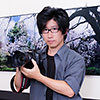Have you ever felt that the shots are somewhat lacking in impact while you are photographing landscapes? In this article, we will introduce techniques to produce impressive landscape shots by making effective use of the camera lens and the composition. (Reported by: Hidehiko Mizuno, Shirou Hagihara)

Fog the lens to create a fantastical effect

EOS 5D Mark III/ EF24-105mm f/4L IS USM/ FL:24mm/ Manual exposure (1/15 sec., f/11)/ ISO 400/ WB: 4,800K
Light from the morning sun penetrated through the trees into the mountain. To stress the ambience created by the morning mist, I fogged the lens with my breath. Doing so diffused the backlight to produce a soft depiction.
If you feel that the shots are somewhat lacking in impact, try fogging the lens with your breath. You will be able to create intriguing effects by adjusting the position and the amount of fog according to the composition and the subject. This effect can be created easily when mist is likely to occur under a low temperature, such as in the morning or at dusk, but note that the camera lens may not fog easily if there is wind blowing. Once the lens is fogged, take your shots immediately. It would be ideal if the entire surface is covered with a uniformly thin layer of fog. The image would look unnatural if the lens is partially cloudy or dry, which causes unevenness in the effect. However, if you want to bring out a specific subject, such as a flower that is your main theme, you can adjust the effect to cover it with a thinner layer of fog.
Technique
Effect varies depending on how the lens is fogged

Image lacks impact when the lens is not fogged
While this image is clear and natural, it looks somewhat monotonous. Long shadows of the trees were created, but the morning rays were not strong enough to create a misty effect.

Blow your breath into the lens and check the effect
This is what it looks like immediately after blowing your breath into the lens. The effect may last longer or shorter depending on the strength and direction of the wind, so you are advised to check the effect carefully while taking a shot.
Including the horizon in the composition for a more impressive landscape shot

EOS 5D Mark III/ EF24-70mm f/2.8L II USM/FL: 24mm/ Aperture-priority AE (5 sec., f/11, -0.7EV)/ ISO 100/ WB: Daylight
I took this shot after the sunset's glow disappeared and when the sky became expressionless. By covering a part of the sky at the upper end using the tree leaves to remove any redundant space, I was able to create an atmosphere of a dense landscape.
In landscape shots with lakes as the subject, the rising or setting sun is often included in the composition. However, one of the challenges lies in how we capture the sky. If there are nicely-shaped clouds that help to add expression to the sky, you can create a strong impact even if it occupies a large part of the composition. On the contrary, it would be difficult to evoke any kind of emotion simply with a blue or a grey overcast sky, or without the presence of vivid-coloured sunrise or sunset glows. To resolve this problem, find a place under the trees by the lakeside and cover the upper part of the image with the branches and leaves. Doing so helps to cover up a portion of the expressionless sky, resulting in a denser composition. However, you need to pay careful attention to the shape of the branches and leaves in this case, specifically, the shape of the branches must be beautiful, and there must not be any large white space between the luxuriant leaves. Additionally, make sure that the background is visible to a certain degree, otherwise the composition would look cramped and stuffy. The ideal choice of lens for such a composition would be a wide-angle zoom. You can tell intuitively that using an angle of view of16mm or 24mm helps to bring out volume in the branches and leaves covering the sky, while emphasising the scale of the landscape. Also, since the lake is the subject, it would look unnatural if the horizon is tilted, so care is needed to ensure that it is level.
Technique
Covering the empty space above the horizon with trees for a denser composition

Composition looks cramped with the branches blocking the view of the mountains in the background
The uneven shapes of the branches give a cluttered impression, resulting in an image that is out of balance. Also, the composition looks cramped as the branches are blocking the view of the mountains in the background. This might be a good composition if the branches were the main theme, but not so if the lake is your subject.

Born in 1968 in Kyoto. The works he has released center on the beautiful scenery, and also the shrines and temples of Kyoto.

Born in 1959 in Yamanashi. After graduating from Nihon University, Hagihara was involved in the launch of the photography magazine, "fukei shashin", where he worked as an editor and a publisher. He later resigned and became a freelance photographer. Currently, Hagihara is engaged in photography and written works centring on natural landscapes. He is a member of the Society of Scientific Photography (SSP).

































